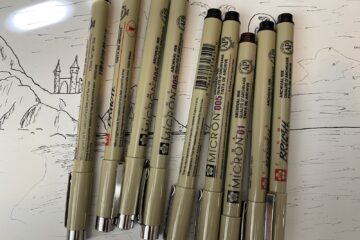I’m not the most likely watercolor evangelist. Most people think about Aunt Bessie’s birds or Aunt Hilda’s flowers when they think of watercolors. Some will think about lovely landscapes.
All are great. Don’t get me wrong.
But most people aren’t thinking of nudes when they think of watercolors. Nudes are associated with oils.
Now, nothing against oils. I have a reason why I haven’t done oils (yet) and it’s explained as one of watercolor’s strengths. Keep reading.
So here are five strengths of watercolors. There are many, many more and I had to nail this down to five to fit in a single article. Needless to say, I’ll eventually write 5 more and 5 even more articles.
Randomness
I don’t like it when people say that you don’t control water because it just does what water wants to do. That sounds like the watercolor paints itself. I can assure you that if you know what you’re doing, that’s not the case.
I prefer to say you “guide” the water.
So yes, you’ll get some randomness in your works, especially when doing washes.
But, you are guiding the water along and if you know what you’re doing, you’re going to get a lot of really cool randomness in your works.
This is the only of the big three (oil, acrylics, and watercolors) that offer randomness in your artwork.
I love that because you can do the same work multiple times and you’ll get a slightly different result each time. So you get an additional layer of uniqueness. That’s a good thing, especially when you’re like me and you have similar themes in multiple paintings.
Portability
You can literally paint anywhere. Of the big three, watercolors are by far the best if you live in a tiny shithole.
Like we did up until a few years ago.
My wife and I had a tiny apartment in a filthy area. The place was grimy and miserable. We had a whopping total of 600 square feet to live in.
There’s no way I could have done oils without stinking up the tiny apartment.
Also, acrylics require too much care of your brushes. Accidentally leave paint on a brush overnight and goodbye brush.
That’s actually why I chose watercolors when I switched from cartooning to art. We had a tiny place and very little livable space.
Watercolors are the easiest of the three to maintain and also the easiest to clean up. And as any artist who’s been doing it for awhile can tell you, you’ll make mistakes. Who hasn’t spilled paint?
Washes
Yes, I did mention randomness earlier. But I really want to bring the point home.
There’s nothing like a watercolor wash. There’s a reason why great artists like Arthur Rackham added watercolors to his illustrations. You’ll know Rackham from everything from Mother Goose to Peter Pan.
Washes can be super simple or they can be multi-layered. It’s up to you and what you want to do with them.
Rackhams’s strength was his illustration/inking and the watercolor added just enough color required by the publishers of those books.
You could of course go the other extreme and make the watercolor wash the primary focus of your works. It’s totally up to you and what you want to accomplish.
I’m personally somewhere in between. My style actually prefers hot press paper rather than cold press. I’ll write more about paper preferences in another article.
Startup costs
You simply need less stuff to get started with watercolors.
You need to buy brushes, watercolor paper, and paints. That’s it.
The other supplies, you probably already have around the house. I use kimchi jars for the water. You can use old spaghetti jars instead.
You should have some paper towels handy too. You might use a sponge. You might not.
I use pencils for drawing and I also ink my watercolors. You don’t even have to do that.
You don’t need thinners, solvents, or any other stinky chemicals.
If you’re just starting and deciding between oils, acrylics, and watercolors, this is yet another thing you should take into consideration.
If you’re concerned about toxicity..
And finally, this relates to a few of the former points. You don’t need thinners or solvents. No fumes either.
So if you’re stuck in a small area, like we used to be, watercolors are definitely the safest choice when we’re talking about your health and safety.
Most watercolor paints are safe (with a few exceptions). Note that some pigments may not qualify as safe. Like cadmium based pigments for instance.

If you’re worried about toxicity, you can avoid certain pigments. Specifically look for ACMI’s AP label to avoid pigments that are less safe.



0 Comments